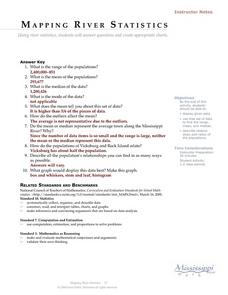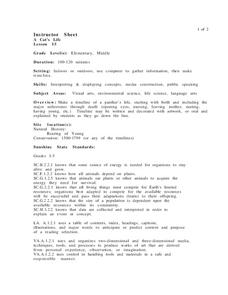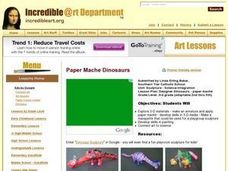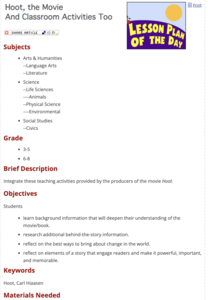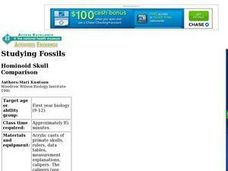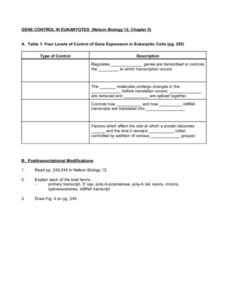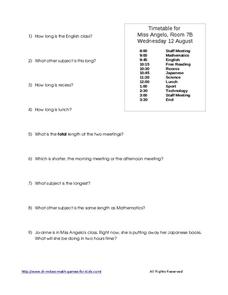Curated OER
Take the One-Tonne Challenge!
Students explore about the One-Tonne Challenge, and work out how they could reduce their greenhouse gas emissions (GHGs) by one tonne, through individual actions and by influencing other people. Students use a GHG emission table to...
Curated OER
Mapping River Statistics
Students research different statistics to do with the Mississippi River. They answer questions about finding data and collect it by conducting research. The research is used to construct a data table. Then students use the table to...
Curated OER
Pump It Up
Young scholars study the anatomy and functions of a heart. For this heart study lesson, students read a book about the heart and study a plaster heart model. Young scholars take their own pulse in various stages of rest as well as active...
Curated OER
Solar System: The Four Inner Planets and Earth's Moon and Astronauts
Second graders read THe Magic School Bus: Lost in the Solar System. In this language arts and science lesson, 2nd graders explore the four inner planets. Students view the inner planets using Google Earth.
Creative Chemistry
The Origins and Maintenance of Earth's Atmosphere
For this atmosphere learning exercise, students read a data table showing the percentages of carbon dioxide, oxygen, and nitrogen in the atmosphere over the last 4500 million years. They then create a graph comparing these gases over...
Curated OER
Evaluating Data
In this data worksheet, students learn how to organize the data collected during an experiment and practice finding patterns. Students graph a table of experimental data and complete 1 short answer question.
Curated OER
Rising Tensions Over The Nile River Basin
Pupils analyze the concept of global commons dilemma. In this investigative lesson students read an article on the Middle East Media Research Institute and answer questions accordingly.
Curated OER
Heating of Water: Water Vapour
Seventh graders read the directions printed on their worksheet and follow them carefully. They set up a beaker with a tripod and Bunsen burner under it. They record the temperature of water every 30 seconds. Students graph the data and...
Curated OER
Fall vs. Spring
Students learn about fall and spring by engaging in hands-on activities in order to fulfill science and language arts standards. In this lesson on seasons, students first listen to a story about fall, discuss the characteristics of the...
Curated OER
A Cat's Life
Students construct a timeline of a panther's life. Students decorate their timeline with illustrations and words, or they can choose to have it orally read to the class. Students use the computer to construct their time-lines. Students...
Curated OER
Simulation Test
Middle schoolers evaluate an ecosystem and consider how it would respond to varied events. In this Earth science lesson, students work in small groups to analyze an ecosystem's response to teacher created scenarios. Student's...
Curated OER
The Lipstick Experiment
In this scientific method activity, students read "The Lipstick Experiment" and then complete the 2 student tasks on the activity. They then answer the 5 questions regarding what they just read. The answers are on the last page.
Curated OER
Designer Dinosaurs - Paper Maché
Third graders explore 3-D materials by making a macquette that could be used for a playgroup sculpture. The students design and execute papier-mâché dinosaurs. They develop painting skills and connect art to science.
Curated OER
Hoot, the Movie And Classroom Activities Too
Students complete various activities for the book and movie "Hoot." They read and analyze the novel, observe wildlife in their neighborhood, and compare/contrast Henry David Thoreau with a main character in the book.
Curated OER
How to verify the relationship between the wavelength and frequency of light
High schoolers collaborate in heterogeneous groups with each student having a different role. They comprehend the relationship between the frequency and wavelength of light. They record their observations in a table that is included on...
Curated OER
Hominoid Skull Comparison
Young scholars are provided with evidence used to support evolutionary theory. They are introduced to classification by using primates as an example. Students read article related to Hominoid Skull Comparison and write a summary about...
Curated OER
Metals, Non-metals, Metalloids
Students discuss the physical and chemical properties of metals and non-metals. As a group, they classify items as a metal or non-metal. Using the periodic table chart, students discuss the characteristics of each metal. Based upon...
Curated OER
Gene Control in Eukaryotes
In this gene control in eukaryotes worksheet, students complete a table with information about the process of translation and transcription. Students also explain the process of post-transcription and the modifications involved.
Curated OER
Acid, Base, or Salt?
In this acids and bases worksheet, students read about the differences between acids and bases and then complete a table comparing the characteristics of both. Then students determine if the given statements describe an acid, base, or...
Curated OER
Why is the Ocean Salty?
In this ocean salt learning exercise, students read about the processes that have lead to the salt content in the ocean. Then students complete 5 short answer questions.
Curated OER
Making Babies
Sixth graders complete a human traits survey. In this genetics lesson students read articles and fill out a worksheet on genotype and phenotypes.
Curated OER
Positive Weather Reports
In this weather report worksheet, students complete a weather report on their favorite season in a group. Students observe and evaluate, complete a table for the report, and present it in a group.
Creative Chemistry
Alkanes and Alkenes
In this alkanes activity, students use a data table to plot a graph of boiling point against the number of carbon atoms. They also define cracking and double bonds. This activity has five short answer questions.
Curated OER
Timetable: subjects for the day
In this time table worksheet, students view the subjects and schedules for different classes for the day and answer time related questions about them. Students look at 4 schedules and answer 31 questions total.

